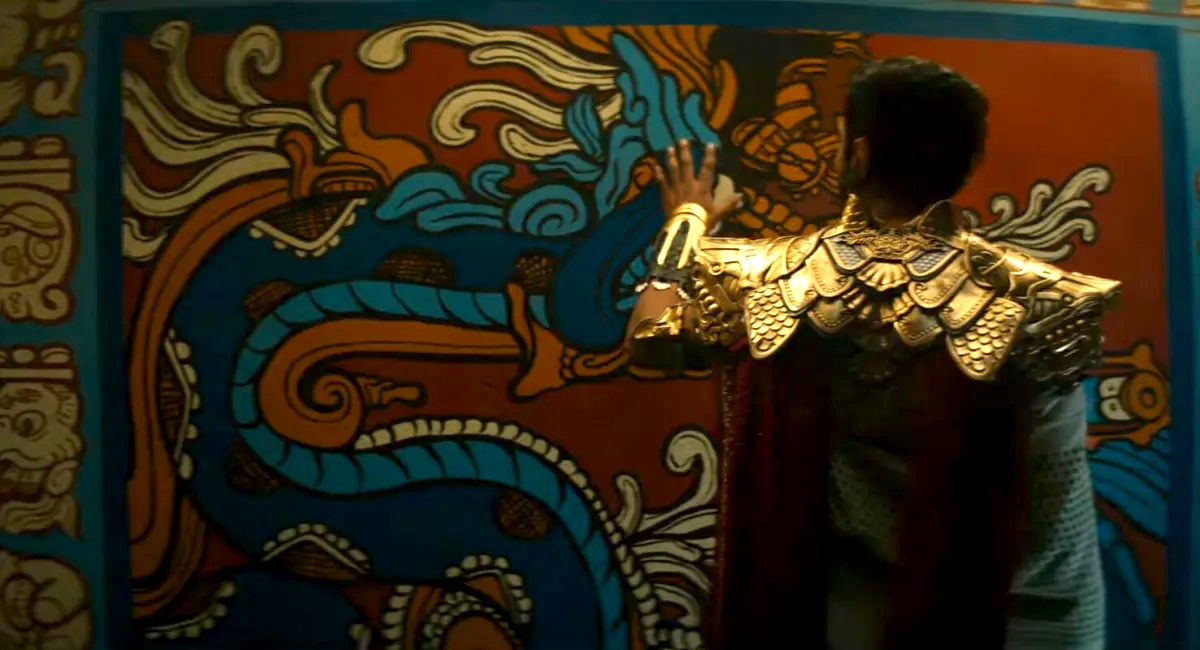What’s the History Behind the New Hand Sign in ‘Black Panther: Wakanda Forever’?
Líik’ik Talokan!

Only time will tell what aspects of Black Panther: Wakanda Forever will become mainstays in pop culture. In the first Black Panther film, it was the iconic arms-crossed “Wakanda Forever!” According to Inverse, in the Blu-ray edition of the film, director Ryan Coogler stated that the gesture was influenced by West African artwork and American Sign Language. This has people wondering about the origins of the similar Talokan gesture “Líik’ik Talokan.” (Rise Talokan!) While on Despierta America (Wake Up America) at Univision Studios in Florida on November 1, Tenoch Huerta (who plays Namor), Mabel Cadena (Namora), and Alex Livinalli (Attuma) spoke on the meaning of the phrase.
After they do the hand gestures, Huerta explains how it can be used.
“What’s going on?” “How are you?” [They all laugh.] “How Goes it Dude?” It’s the greeting that’s done with respect. That has to do with the sun and opening things. It’s like that, but if y’all use it like “What’s up, dude?” – it works.
Livinalli continued with excitement and pride,
Something that I think people should know—something that’s really important in Black Panther is the “Wakanda Forever” phrase and greeting. It’s a very powerful phrase, that’s really strong. Together we felt like [Talokans] needed their own phrase/salute.
This didn’t get as much attention until after the movie for non-Univison watchers. However, it’s definitely made the rounds since. A few days later, in an interview with Cinemablend, Livinalli and Cadena spoke about how this wasn’t in the original script. Working with Coolger and the Yucatec Maya language instructor, they came up with “Líik’ik Talokan!” This language spoken in the movie is one of six proto-Mayan languages spoken today by over 800,000 people. Across the entire language family, there’s over two dozen Mayan languages, and altogether, it’s spoken by over six million people, mostly across Mexico, Belize, Guatemala, El Salvador, Honduras, and the U.S.
The hand sign

There are a lot of rumors about where the hand sign itself came from, but without hearing from the production designer, Hannah Beachler, a.k.a. the person behind the Wakanda and Talokan “bibles,” there’s no confirmation. We do know that Talokan was created in 1571, but was a branch of an existing Mayan Empire. The Mayans stretch back to at least 1500 B.C. Like other cultures stretching back that far in time, they used pictographic texts, a.k.a. writing languages that use images as distinct symbols rather than letters.
Even if you have little knowledge of Mesoamerican history, you’ve seen this in Mesopotamian, Greek, and Egyptian art, too. There’s an argument that emoji usage is a common use of this tradition now. The gesture has been seen in most of these cultures partially because pictographic text depicting humans has some limitations. The gesture works as a way to show communication on a 2D plane but is also transferred to reliefs and 3D sculptures. Because the hand sign appears to be a greeting in several Mesoamerican codices, many believe that this was the source of inspiration.
In the film, they use it towards one another, but like Huerta alluded to in the interview at Univision Studios, sometimes it’s facing the Sun. A Sun-like energy force was seen in the city of Talokan in the film. Like emojis, one symbol can be read in several different ways.
While Talokan uses Yucatec Maya as its language, there are a lot of other heavy ties to Aztec (contemporary Nahuas) culture. The city’s name, Tlālōcān, and the idea of a “feathered Serpent” (Quetzalcoatl) are two big references. It’s very important to remember that the Talokans are inspired by distinct and different peoples, just like Wakanda was a fictional world built from real people with distinct histories. Many Indigenous creators have stressed this because everywhere ravaged by colonialism (all of the Americas) have seen these groups homogenized in depictions.
Related: Wakanda Forever Confronts the Legacies of Colonialism, Not Its Causes on The Escapist
Whether this reasoning is 100% the origin or not, there are lots of cultural ties within the region that many Mexican and Latinx viewers have made connections to. For example, as Remezcla noted, thousands online are using references to Dragon Ball Z, Street Fighter, and Power Rangers. I’m not sure how big Power Rangers and Street Fighter are in what is now Mexico, but anime like Dragon Ball Z is extremely popular, and it wouldn’t be the first anime reference in Black Panther. I didn’t even know white weebs existed until I was an adult because all the kids I knew who ran like Naruto on track and field day and P.E. were all brown.
(featured image: Marvel Entertainment)
—The Mary Sue has a strict comment policy that forbids, but is not limited to, personal insults toward anyone, hate speech, and trolling.—
Have a tip we should know? [email protected]
